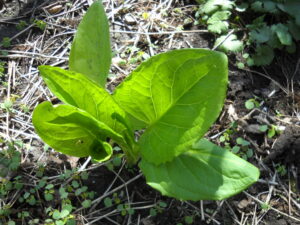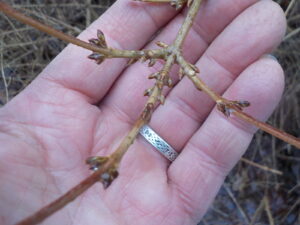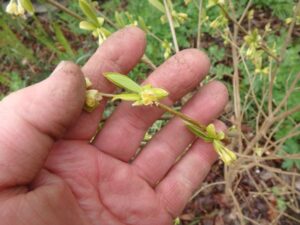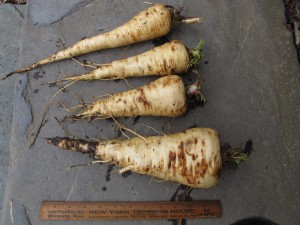Early Harbingers of Spring
Here in Cornish Flat, New Hampshire, we recently had our first day that shouted “SPRING IS HERE!” After a night of cool rain, the sun came out and temperatures climbed into the 50’s. Now all we need are spring flowers. Me? I solved that problem by potting up bulbs last November and storing them in my cool basement. They rested, grew roots, and now my windowsills are crammed with pots of daffodils and crocus, some blooming, others on the way. They will help to keep my spirits up when we get, as I know we will, day after day of gray drizzle before summer gets here.
Skunk cabbage (Symplocarpus foetidus) is related to the common Jack-in-the-pulpit we all know and love. Like Jack, its flower is hidden inside a spathe, or outer leafy jacket. I bought a skunk cabbage plant at Garden in the Woods, a native plant sanctuary in Framingham, MA about 25 years ago.
Forsythia is a nice yellow-blossomed shrub originally from Asia and eastern Europe. Michael Dirr, my woody plant guru, describes it this way: “Rank-growing, deciduous shrub, differentially developing upright and arching canes which give it the appearance that the roots were stuck in an electric socket; always needs grooming, one of the most over-rated and over-used shrubs; will sucker (slowly) to form large colonies.” That from his “Manual of Woody Landscape Plants”, my favorite text on trees and shrubs.
In contrast to the flamboyant forsythia is a nice native, leatherwood (Dirca palustris). This understated plant blooms just as it leafs out in March, April or early May, depending on where you are. It does best in full shade. Although Dirr’s book says it prefers a moist, dark soil, I have it in a dry location and it does just fine. The blossoms are pale to bright yellow, small, but plentiful. The bark is a handsome gray. But it is hard to find in a plant nursery. I bought one several years ago and have looked for others, but have not found another nicely shaped specimen. Look for it. Slow growing, it requires little or no care.
Hastening Spring
I don’t know about you, but I’m tired of cold, raw, rainy days. And I really don’t want any more snow or slush. We’ve had some good warm and sunny days, but I know I shouldn’t expect them consistently yet. There are things I do to make me feel like spring and summer are on the way, even when it’s sleeting outside.
A couple of weeks ago I picked some stems of forsythia, that old fashioned shrub that displays mounds of bright yellow flowers long before most other shrubs bloom. By now these seemingly lifeless branches are loaded with flowers in full bloom on a sunny windowsill in my house.
The key to forcing forsythia is to pick twigs that grew last year – young, vigorous stems – that are loaded with pointy buds about a quarter of an inch long. These are the flowers buds. Cut stems 18-24 inches long and put in a vase on a sunny windowsill. It took less than a week for mine to bloom.
I pick flowers now, too. Right now I only have two things in bloom outdoors: snowdrops and glory of the snow. Snow drops are demure, understated white flowers that only grow 4-8 inches tall, and tend to stay on the shorter end of that range. I have a thousand or more in bloom now because I started transplanting them from my parents’ gardens back in the 1980’s and they have naturalized and spread by seed. They have spread out into my lawn, blossoming in clumps of a dozen or so.
Glory of the snow (Chionodaxa spp.) is another great early spring bloomer. I have the classic blue/purple ones as well as some less common pink ones. These diminutive beauties look up, showing their open throats, which are white and contrast nicely with their blue petals. Many gardeners ignore the small bulb plants, focusing on daffodils and tulips which are more dramatic when they bloom. But I like early blossoms, and have planted plenty of these small wonders, too. The time to plant is in the fall, September and October.
Now is the time to order spring bulbs – I know where the holes are in my planting space, and I know what I need to order. So I called Becky Heath, co-owner of Brent and Becky’s Bulbs in Gloucester, VA to order up more spring bulbs to plant next fall (www.brentandbeckysbulbs.com or 804-693-3966). I asked for the very earliest of crocus, as I mostly have late-blooming ones. Becky suggested ‘Blue Pearl’ and “Blue Bird’ (both varieties of Crocus crysanthus) as good early bloomers, and a species called Crocus tommassinianus.
I gave Becky my credit card info and asked her to fill up a $50 order with anything nice that is early. Later that day she emailed the details of the order which included some winter aconite (Eranthis spp.), a nice low yellow flower, and 2 species of Scilla, great deep purple flowers. I have both, but not enough. They will ship bulbs in September, but for now I will just mark the spaces where they should go with tags. Brent and Becky’s is one of the few remaining family-owned bulbs companies, and I like to support any family-run business that I can.
Pussy willows are starting to appear along my stream, and I will go pick some this week. The gray furry “pussies” are actually the flowers of a type of willow. If you pick them when still closed up, put them in water to get them to open. If they look fine when you pick them, just place them in a dry vase. They will not change in appearance if you keep them dry. In water they will go through their life cycle, producing yellow pollen and dropping it on your table.
If you planted tulips last fall, the foliage should be showing by now. Deer love tulips, and some of my gardening friends have given up on them because of the deer. My suggestion? Put chicken wire teepees around clumps of tulips now, and keep them in place until after they have blossomed. And pick the blossoms when they are just about to open up. Most of us spend more time in the house than in the garden, so having cut flowers indoors makes sense to me.
When I shopped for groceries recently a got a nice slump of daffodils in bud, 10 stems for $3.99. I have daffies coming along outside, but I want some now. But store daffodils can be iffy. Sometimes they don’t open up, or appear dehydrated and wrinkly. You are always sure to get good flowers from a florist, or from a store with a good floral department. In my experience, big grocery stores don’t always have great ones. It is always important to cut off ¾ of an inch of stem and put in water as soon as you get home.
Lastly, I know summer is coming when I eat my first fresh garden vegetables. This year that was on April 11, when I dug some parsnips. Parsnips look like big white carrots, and are delicious after a winter in the ground, getting sweeter. I boil them, then serve with new maple syrup, raisins and walnuts. Spring is on the way!
Henry’s website is www.Gardening-guy.com. You can reach him at henry.homeyer@comcast.net or P.O. Box 364, Cornish Flat, NH 03746.








